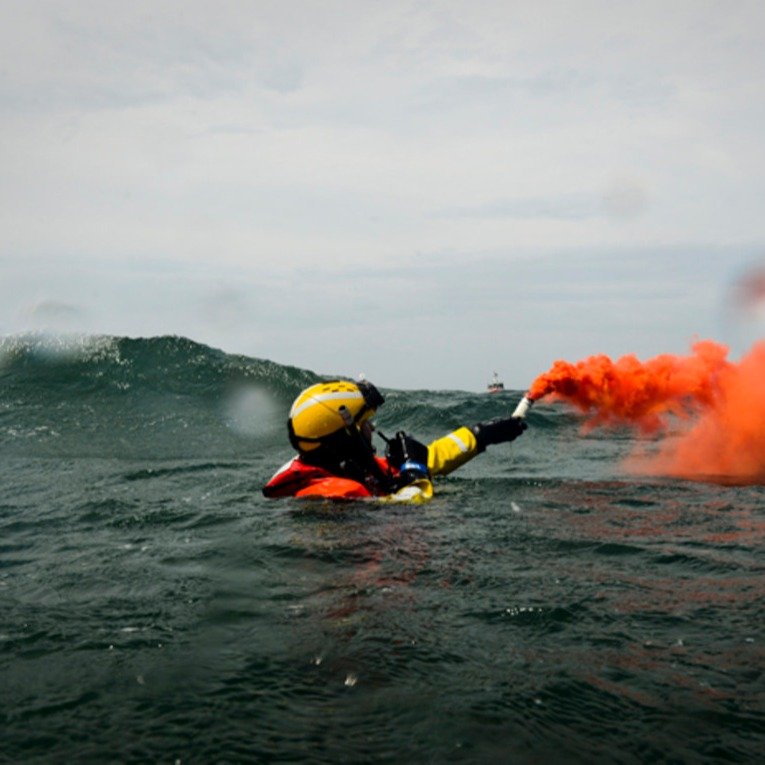THE KEYS TO SURVIVAL AT SEA
It is a very real scenario that affects every boater on the water. You are out on a boat alone and you fall overboard with no way to get back. The danger of being alone in the water becomes a life-or-death situation.
If you can access your life-raft or flares, these can life-saving actions and will increase your likelihood of being spotted at sea, but if you are on your own and suddenly fall into the water you may only have on you what is immediately in reach.
There are a number of factors affecting your timeline for survival, and there are steps you can take to maximise your chance of rescue.
FACTORS AFFECTING SURVIVAL
Depending on the situation, your ability to stay in the water for long periods of time is determined by many elements. Firstly, environmental factors will have a huge say in how long you can survive. For example, weather conditions, water temperature, body of water and proximity to hazards.
Also, wave height, wind speed, time until last or first light and even the threat of predators can be the difference between surviving 10 hours in the water or just 10 seconds.
Individual factors such as your age, level of fitness, type of clothing you are wearing, as well as taking into account the last time you had food and drink are all factors that will impact your chance of survival. Physical injuries or your mental and emotional disposition must also be considered.
YOUR BEST CHANCE OF SURVIVAL
Wear a lifejacket
The single most important piece of equipment to increase your chance of surviving an overboard situation is to wear a lifejacket, and it is advised by all major organisations that you put one on as soon as you step aboard. Most boaters who drown on Australian waterways were not wearing a lifejecket when they entered the water.
In 2021, Authorities in Australia urged people to wear lifejackets out on the water after a spate of drownings throughout Victoria and New South Wales.
"Wear a life jacket, wear the appropriate gear, let someone know where you're going,” said Shane Daw, general manager of coastal safety at Surf Life Saving Australia.
A lifejacket acts as a support in the water, reducing fatigue. Its flotation device lifts your airway above the water and keeps you buoyant, decreasing the risk of drowning.
Additionally, a lifejacket fitted with a EPIRB will alert rescue authorities immediately when it hits the water, decreasing the response time and increasing the likelihood of survival.
Appropriate clothing
To reduce the risk of hypothermia it is recommended to wear the right clothing for the conditions. People can still get hypothermia in warm water, and a waterproof jacket should be worn in most circumstances out on the water.
A reduction in body temperature below 35 degrees celsius will cause you to become hypothermic, even if its effects take longer to set it.
For heat retention, even a small item of clothing like a hat or beanie can be crucial, and authorities advise to never discard any clothing, even if it feels like it is drenched in water.
Stay calm
Survival hangs on planning for emergencies and the ability to make good, informed decisions under pressure.
Fatigue and dehydration are the first things to set in. Do not drink salt water, as it actually speeds up dehydration. Instead, conserve your energy by floating motionless in the water.
Pull your knees up and fold your arms across your chest to conserve heat, and if you find yourself in a group, huddle together to support everyone's weight. If you are out of sight of land do not attempt to swim, you will just lose more heat than you’ll gain.
It could be hours before a rescue effort is deployed and authorities find your location, so keep in perspective the time it takes to launch a response. Above all, do not panic.
Download the Deckee app from the App Store or Google Play for free to stay safe on the water. Check the marine weather forecast, track your boat trips, inspect Aids to Navigation, and more. Join our community of passionate boaters to find and share your favourite anchorages, marinas, or fishing spots.


